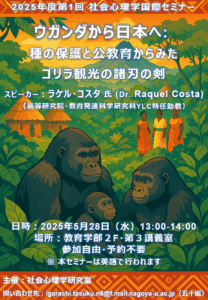2025年度第1回社会心理学国際セミナーを開催します

下記の日程で国際セミナーを開催します。スピーカーはラケル・コスタ先生(高等研究院・教育発達科学研究科YLC特任助教)です。講演は英語で行われます。多くの皆様のご参加をお待ちしています。
日時:2025年5月28日(水)13:00-14:00
場所:名古屋大学教育学部2F・第3講義室
主催:社会心理学研究室
参加自由・予約不要
問い合わせ先:igarashi.tasuku.n6@f.mail.nagoya-u.ac.jp(五十嵐)
###
タイトル:ウガンダから日本へ: 種の保護と公教育からみたゴリラ観光の諸刃の剣
観光は、種の保全に大きな影響を与える可能性があります。これは特にその生息地の象徴的な種、すなわち旗艦種や傘種となる動物に関連する場合に顕著です。有名な例はゴリラ観光です。ゴリラ観光は保護活動の重要な資金提供源となり、ニシローランドゴリラ(Gorilla beringei beringei)の個体数増加に大きく貢献するだけでなく、他の国立公園の支援にもつながり、地域社会の雇用を創出します。しかし、ツーリズムの研究では観光客が霊長類にネガティブな影響を及ぼす可能性が指摘されており、ゴリラ観光の持続可能性についての懸念が示されています。
本セミナーでは、まずウガンダのブウィンディ原生国立公園での調査を元に、観光客の存在がニシローランドゴリラの集団に与える影響について紹介します。具体的には、観光客の繁忙期と閑散期におけるゴリラのストレスシグナル、ストレス対処メカニズム、社会的結束の変化を検討しました。ウガンダでゴリラを訪れる観光客の60%は、ガイドライン(最低7メートルの距離)に反し、3メートル以内の距離で観察を行っていました。この距離では、ゴリラ(および人間)の身体的相互作用や攻撃的相互作用が増え、病気の伝染リスクが高まります。このことは「なぜ人間は自身の安全を危険にさらしてまで野生動物に近づくのか?」という疑問を提起します。フォローアップ調査では、飼育環境下において、ゴリラが動物園の来園者にとって最も人気のある種であることがわかりました。特定の種が好まれる理由は明確ではありませんが、動物とのつながりを強く感じている観光客は、野生生物を保護したり、種の保全について学ぶ意欲が高いことがわかりました。ただし、動物園の訪問頻度や滞在時間はつながりの感覚に直接影響を与えませんでした。
これらの知見を総合すると、動物園は、野生生物との責任ある相互作用や持続可能なツーリズムについて、一般市民を対象とした啓蒙活動に重要な役割を果たす可能性が示唆されます。鍵となるのは訪問の頻度ではなく、相互作用の質かもしれません。本セミナーは、野外研究に基づく洞察と飼育環境下の研究知見を統合することで、観光、種の保全、動物福祉の複雑な相互作用を明らかにし、バランスの取れた実現可能なポリシーを策定するためのヒントを提供します。
Uganda to Japan: The double-edged sword of gorilla tourism over species conservation and public education
Tourism can have a significant impact on the conservation of species, especially when it involves emblematic species that serve as flagship and umbrella for their habitat. A celebrated example of this phenomenon is Gorilla Tourism, which is often advocated as a primary driver for the growth of the population of mountain gorillas (Gorilla beringei beringei) through funding the protection of their habitat. In addition, Gorilla Tourism supports other parks and creates jobs for local communities. However, research indicates that tourists can exert negative influences on primate species, leading to reasonable concerns that gorillas may also experience similar adverse effects, undermining the sustainability of this practice. In this seminar, we will first discuss how tourist presence affects one group of mountain gorillas in Bwindi Impenetrable National Park, Uganda. Specifically, we will examine stress signals, stress-coping mechanisms, and changes in social cohesion among the gorillas during periods with and without tourist visits. Contrary to the guidelines of Tourism for observing Great Apes (minimum 7 m distance), tourists visiting gorillas in Uganda spent 60% of their viewing time within 3 m of the gorillas. At this distance, gorillas (and humans) increased physical interactions and agonistic interactions, raising the chances for disease transmission. This raises the question: "Why do people approach wild animals at the risk of their own wellbeing?". In a subsequent study conducted in captivity, we found that gorillas are the most popular species among zoo visitors. While it is not clear why visitors prefer some species over others, we found that visitors who scored higher on measures of connection to animals also showed greater motivation to protect wildlife and learn about conservation. However, the frequency or duration of animal observation did not directly influence these connection rates. Put together, these findings underscore the potential for zoos to play a pivotal role in educating the public about responsible wildlife interactions and sustainable tourism practices. The key may lie in the quality of the interaction rather than its frequency. By integrating field-based insights with captive studies, our research highlights the complex interplay between tourism, conservation, and animal welfare, offering actionable recommendations for balancing these priorities.